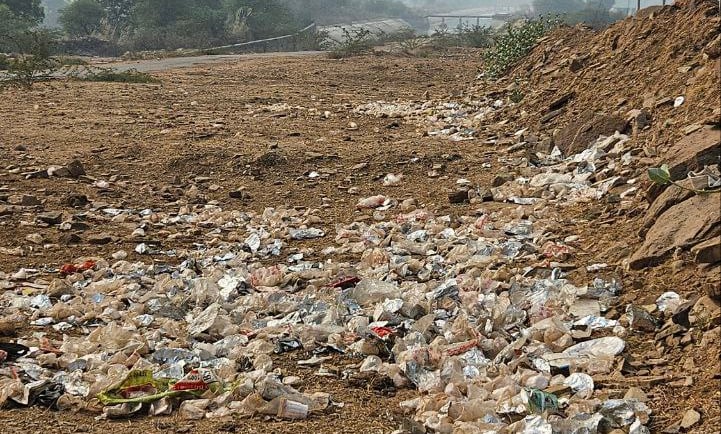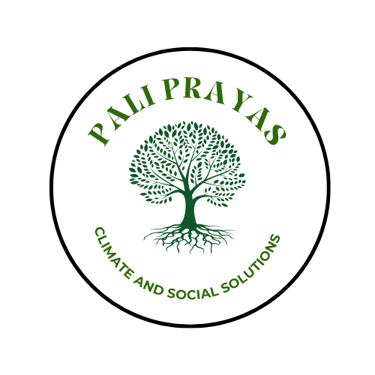The Problem with Rural India's FMCG Boom and Its Impact on the Plastic Waste Crisis in the Villages


The Fast-Moving Consumer Goods (FMCG) industry is one of the fastest-growing sectors in India, driven by increased consumer demand and rural market expansion. The Fast-Moving Consumer Goods (FMCG) market comprises products sold quickly and relatively cheaply. These include packaged foods, beverages, toiletries, cosmetics, cleaning supplies, and personal care products. FMCG items have high consumer demand and a short shelf life due to perishability or frequent usage. Over the last two years, rural households have expanded their average FMCG basket size by 60%, rising from 5.88 products in 2022 to 9.3 in 2024. While this growth reflects increased accessibility and purchasing power, it also presents a largely ignored environmental challenge—plastic waste.
Most FMCG products are packaged in multi-layered plastic (MLP), which is nearly impossible to recycle. With weak or nonexistent waste collection systems in rural areas, this plastic waste often ends up in agricultural fields, obstructing seed germination and reducing soil productivity. Worse, a significant portion is burned in the open, contributing to India’s staggering 5.8 million tonnes of annual plastic waste incineration, releasing toxic pollutants that harm both human health and the environment.
Despite the Swachh Bharat Mission - Grameen (SBM-G) claiming nationwide coverage of solid and liquid waste management facilities, the reality on the ground tells a different story. Our field visit to a village in Morena district, Madhya Pradesh, revealed that waste management structures were merely symbolic. They were unused for their intended purpose and often repurposed by locals for unrelated activities. Without proper waste collection, manpower, and vehicles, these initiatives remain ineffective, exacerbating rural India's plastic crisis.
Is FMCG Boom in Rural India is a Double-Edged Sword?
India’s rural economy has rapidly developed, with FMCG growth outpacing urban areas by 2-3% annually. Rural consumers increasingly purchase packaged foods, beverages, toiletries, detergents, and personal care products, most of which come in single-use, non-recyclable, multi-layered packaging.
The expansion of FMCG in rural India is driven by:
Higher rural incomes due to improved agricultural production and government schemes.
Increased rural penetration by major FMCG companies, with targeted products and smaller, affordable packaging.
Shifts in consumption patterns, where rural households now rely more on branded packaged products than traditional homemade alternatives.
While these factors contribute to economic growth and better living standards, they also create unmanaged plastic waste. The lack of municipal waste services in rural areas means this waste either remains in the environment or is burned in the open, contributing to pollution.
The Challenge of Multi-Layered Packaging (MLP)
Unlike single-layer plastic, multi-layered packaging—used for chips, biscuits, snacks, and personal care items—cannot be recycled through conventional methods. It consists of different plastic layers fused with aluminum or paper, making it almost impossible to separate and process.
According to Central Pollution Control Boards (CPCB) reports, India generates 3.4 million tonnes of multi-layered plastic waste annually, with most of it either burned, dumped in landfills, or left to pollute the environment. In rural areas, where no formal collection or recycling mechanisms exist, MLP waste poses a serious threat to soil health, water bodies, and air quality.
Impact on Agriculture
Obstructed Seed Germination: There are plenty of reports that have revealed that plastic waste left in fields blocks seed sprouting, reducing crop yields.
Soil Contamination: Over time, plastic debris breaks down into microplastics, altering soil composition and affecting microbial activity.
Reduced Land Fertility: The presence of plastic in agricultural land disrupts natural nutrient cycles, making the soil less fertile.
Air Pollution and Health Risks
Burning FMCG plastic waste releases dioxins, furans, and other toxic chemicals, leading to:
Respiratory diseases such as asthma, bronchitis, and lung infections.
Increased cancer risk due to long-term exposure to carcinogenic pollutants.
Environmental damage as pollutants settle into water bodies and enter the food chain.
Swachh Bharat Mission - Grameen (SBM-G): A Flawed Approach
The Swachh Bharat Mission - Grameen (SBM-G) budget for 2024-25 is ₹7,192 crore, aimed at solid and liquid waste management in rural areas. According to official data, all villages are covered under SBM-G for waste management facilities. However, this claim is misleading.
The primary issues with SBM-G implementation include:
No Waste Collection Mechanism: Even though structures exist, there is no organized collection system to transport waste to disposal or processing units.
Lack of Manpower and Vehicles: Without waste workers or transport vehicles, waste accumulates in fields and common areas.
Neglected Infrastructure: Many waste management centers remain unused, underutilized, or repurposed due to lack of awareness or operational inefficiencies.
During our visit to a village in Morena district, Madhya Pradesh, we found a waste management structure standing idle, used not for solid waste management, but as a shelter for cow dung and other organic waste. This is not an isolated case but similar conditions exist across many rural areas, making SBM-G ineffective in tackling plastic waste.
The Way Forward: Solutions for Rural Plastic Waste Management
To address the FMCG plastic crisis in rural India, a multi-pronged approach is required:
Shift from Multi-Layered Packaging to Sustainable Alternatives
FMCG companies should be legally mandated to transition to recyclable or biodegradable packaging.
Incentives for companies that develop eco-friendly packaging solutions.
They should be mandated to adopt Extended Producer Responsibility (EPR), where FMCG companies take back their plastic waste.
Decentralized Waste Collection and Management
Instead of only constructing waste centers, SBM-G should focus on regular waste collection systems with proper manpower and logistics.
Village-level waste segregation and collection points to prevent open dumping.
Strict Enforcement of Plastic Waste Management Rules
Implementation of the Plastic Waste Management Rules, 2016, with specific provisions for rural waste management.
Fines for open burning of plastic waste, coupled with awareness campaigns about its harmful effects.
Integration with Local Governance and Rural Employment Schemes
Using MGNREGA funds to employ local waste collectors, ensuring proper collection and disposal.
Training Self-Help Groups (SHGs) in plastic waste recycling and alternative livelihood generation.
The rise of FMCG consumption in rural India is an indicator of economic progress, but its environmental consequences cannot be ignored. Multi-layered plastic waste is an escalating crisis, choking fields, contaminating soil, and polluting the air. While SBM-G claims to provide waste management solutions, the lack of collection, manpower, and resources renders it ineffective.
A shift in policy focus—from infrastructure development to operational efficiency and waste collection—is urgently needed. As FMCG continues to expand in rural India, so must our strategies for managing the waste it generates. Rural India deserves both progress and sustainability—not a future buried under plastic.
